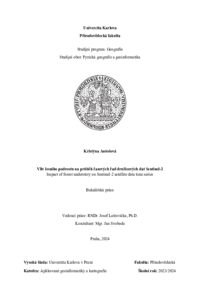Vliv lesního podrostu na průběh časových řad družicových dat Sentinel-2
Impact of forest understory on Sentinel-2 satellite data time series
bachelor thesis (DEFENDED)

View/
Permanent link
http://hdl.handle.net/20.500.11956/189746Identifiers
Study Information System: 263514
Collections
- Kvalifikační práce [20326]
Author
Advisor
Consultant
Svoboda, Jan
Referee
Štych, Přemysl
Faculty / Institute
Faculty of Science
Discipline
Physical Geography and Geoinformatics
Department
Department of Applied Geoinformatics and Cartography
Date of defense
28. 5. 2024
Publisher
Univerzita Karlova, Přírodovědecká fakultaLanguage
Czech
Grade
Excellent
V této práci byly porovnány časové řady družicové mise Sentinel-2 za účelem pozorování rozdílných typů lesních podrostů. Cílem bylo zjistit vliv typu podrostu a fyzicko-geografických vlastností vybraných stanovišť na průběhy křivek časových řad. V rámci terénního průzkumu byly pomocí GNSS přesně vymezeny vybrané lokality, u kterých byly zkoumány botanické a fyzicko-geografické charakteristiky. Následně byly v GEE analyzovány křivky spektrální odrazivosti pro jednotlivá stanoviště v různých částech roku a dále byly sestaveny časové řady vegetačních indexů NDVI a NDMI, teplot a srážek mezi roky 2017 a 2024. V mimovegetačním období vykazují křivky spektrální odrazivosti jednotlivých stanovišť vyšší variabilitu hodnot než ve vegetačním období. Jako nejvhodnější pásma pro snímání podrostu se jevila pásma SWIR 1 a SWIR 2. Časové řady vegetačních indexů byly statisticky testovány pro vymezení rozdílnosti v rámci jednotlivých lokalit. Ve většině případů byla pro jednotlivé porovnávané páry lokalit potvrzena hypotéza jejich rozdílnosti na základě časových řad NDVI a NDMI. Index NDMI se jevil jako vhodnější pro odlišení jednotlivých lokalit.
In this paper, time series of the Sentinel-2 satellite mission were compared to observe different types of forest understory. The aim was to determine the influence of understory type and physical-geographical characteristics of the selected localities on the time series curves. During the field research, selected sites were precisely located using GNSS, therefore, their botanical and physical-geographical characteristics were explored. Subsequently, the spectral reflectance curves for individual localities at different times of the year were analysed in GEE, and time series of vegetation indices NDVI and NDMI, temperature and precipitation from 2017 to 2024 were also created. In the none-growing season, the spectral reflectance curves of single localities showed higher variability compared to the growing season. The most appropriate bands for observing understory appeared to be SWIR 1 and SWIR 2. The time series of vegetation indices were statistically tested to delineate differences within sites. In most cases, for the pairs of sites being compared based on the NDVI and NDMI time series the hypothesis of dissimilarity was confirmed. The NDMI index appeared to be more appropriate than NDVI for distinguishing between sites.
